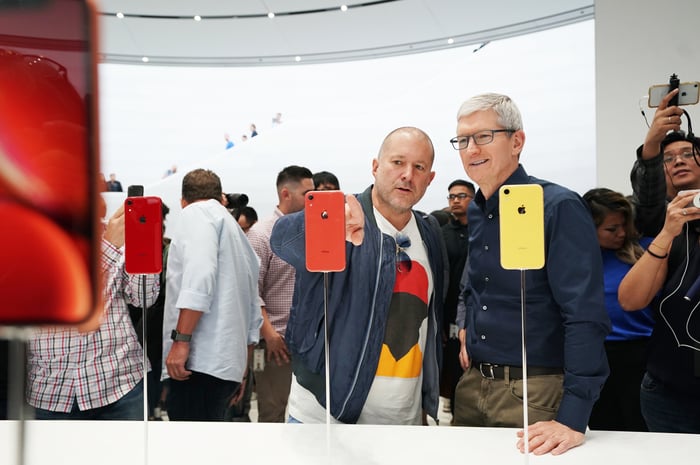On Sept. 12, Apple (AAPL -2.41%) introduced three new iPhones: iPhone Xs, iPhone Xs Max, and iPhone XR. The first two represent Apple's best devices, and the company is charging a pretty penny for them (they start at $999 and $1099 for the baseline configurations, respectively). The last one is the more price-friendly option, starting at $749 -- a full $250 cheaper than the entry-level iPhone Xs.
To achieve this lower price point, Apple has made some sacrifices. For example, the iPhone XR uses a cheaper liquid crystal display (LCD) instead of the organic light emitting diode (OLED) displays found on its more expensive siblings. The device's casing is made of aluminum instead of pricier stainless steel, it has only a single rear-facing camera (the iPhone Xs and iPhone Xs Max have dual rear-facing cameras, which means higher component costs), it doesn't support gigabit LTE, and it's rumored to incorporate only 3GB of system memory instead of 4GB, as found in its higher-end counterparts.

Image source: Apple.
In short, the iPhone XR can be priced lower than the iPhone Xs and iPhone Xs Max because it's cheaper to make.
Back in February, Bloomberg drew a comparison between the then-upcoming iPhone XR and the ill-fated iPhone 5c, saying the following:
Apple has tried selling cheaper phones in the past with poor results. In 2013, the company debuted the iPhone 5c, which had a polycarbonate body and came in various colors. Consumers quickly discovered that for a mere $100 more they could buy a 5s, which had an aluminum body, a slow-motion video camera and a fingerprint scanner. Apple soon discontinued the 5c.
In this column, I'd like to give two reasons why the iPhone XR won't suffer the same fate as the iPhone 5c.
1. iPhone XR retains core iPhone Xs goodness
Although the iPhone Xs and iPhone Xs Max are clearly higher-end devices than the iPhone XR, it's important to note that the iPhone 5c was, in effect, the prior-generation iPhone 5 stuck in a cheaper-to-make plastic casing. This meant it lacked all of the tech spec upgrades that the iPhone 5s got, and to boot, it didn't include Apple's then-new (and quite nifty) Touch ID fingerprint scanning feature.
The situation isn't the same with the iPhone XR. The iPhone XR uses the same A12 Bionic processor that powers the iPhone Xs and Xs Max, it incorporates the same basic camera technology as its higher-end siblings (the main difference is that the higher-end models have a second telephoto lens), and it even has Apple's TrueDepth camera (enabling features like Face ID and Animoji).
In short, the iPhone XR is very much a next-generation iPhone, while the iPhone 5c wasn't.
2. The price gap is bigger
As Bloomberg rightly observes, it took a "mere $100 more" back in 2013 to get the iPhone 5s instead of the iPhone 5c. The price gap this time around is significantly larger, at $250 between models with comparable storage configurations. On top of that, the absolute price points of iPhones have gone up dramatically since 2013.
For some perspective, the iPhone 5s started at $649 and went up to $849 for the configuration with the maximum amount of storage. The iPhone Xs, on the other hand, starts at $999. While the jump from $549 to $649 was affordable for most customers (especially considering that carrier contracts helped mask the underlying prices of the devices back then), moving up from $749 (which might already be prohibitive to many customers, which is why Apple keeps older, discounted iPhones in its lineup) to $999 could be too much.





